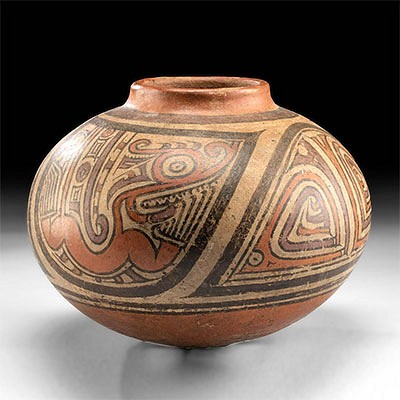Chavin Stone Tablet / Necklace - Jaguar Finials
Lot 101b
About Seller
Artemis Fine Arts
686 S Taylor Ave, Ste 106
Louisville, CO 80027
United States
Selling antiquities, ancient and ethnographic art online since 1993, Artemis Gallery specializes in Classical Antiquities (Egyptian, Greek, Roman, Near Eastern), Asian, Pre-Columbian, African / Tribal / Oceanographic art. Our extensive inventory includes pottery, stone, metal, wood, glass and textil...Read more
Categories
Estimate:
$1,800 - $2,700
Absentee vs Live bid
Two ways to bid:
- Leave a max absentee bid and the platform will bid on your behalf up to your maximum bid during the live auction.
- Bid live during the auction and your bids will be submitted real-time to the auctioneer.
Bid Increments
| Price | Bid Increment |
|---|---|
| $0 | $25 |
| $300 | $50 |
| $1,000 | $100 |
| $2,000 | $250 |
| $5,000 | $500 |
| $10,000 | $1,000 |
| $20,000 | $2,500 |
| $50,000 | $5,000 |
| $100,000 | $10,000 |
| $200,000 | $20,000 |
About Auction
By Artemis Fine Arts
Apr 15, 2021
Set Reminder
2021-04-15 10:00:00
2021-04-15 10:00:00
America/New_York
Bidsquare
Bidsquare : VARIETY SALE | Ancient & Ethnographic Art
https://www.bidsquare.com/auctions/artemis-gallery/variety-sale-ancient-ethnographic-art-6811
Featuring classical antiquities, ancient and ethnographic art from cultures encompassing the globe. Egyptian, Greek, Roman, Etruscan, Near Eastern, Asian, Pre-Columbian, Native American, African / Tribal, Oceanic, Spanish Colonial, Russian, Fossils, Fine Art, more! Artemis Fine Arts info@artemisgallery.com
Featuring classical antiquities, ancient and ethnographic art from cultures encompassing the globe. Egyptian, Greek, Roman, Etruscan, Near Eastern, Asian, Pre-Columbian, Native American, African / Tribal, Oceanic, Spanish Colonial, Russian, Fossils, Fine Art, more! Artemis Fine Arts info@artemisgallery.com
- Lot Description
Pre-Columbian, Peru, Chavin, Jequetepeque valley, ca. 700 to 400 BCE. A fantastic stone tablet or tray used in the ingestion of hallucinogenic drugs. The tablet is a long, ovoid shape with a shallow bowl; at its top, carved from the same piece of stone are two finials in the form of standing jaguars. Between the legs of each is a rounded perforation, and between the two animals is a third round perforation, all three used for suspending the piece as a necklace from the neck of a shaman. The animals have simple, slightly abstracted forms, and one is larger than the other. Size: 6" W x 3" H (15.2 cm x 7.6 cm)
Snuff trays were part of the elaborate battery of objects carefully manufactured by ancient Andeans in order to ingest a ground drug known as vilca or huilca, found in southern Peru and Bolivia, and obtained from the beans of the tree Anadenanthera colubrina. We know of these trays from burials, where they were placed as offerings and perhaps to provision the dead alongside inhalation tubes and other paraphernalia. Feline heads are some of the most iconographically important, and therefore common, artistic themes on snuff trays from this region. They are associated with the use of psychoactive substances that could "transform" a shaman or priest into a feline.
Provenance: private Hawaii, USA collection; ex-Westermann collection, Germany, acquired 1960s
All items legal to buy/sell under U.S. Statute covering cultural patrimony Code 2600, CHAPTER 14, and are guaranteed to be as described or your money back.
A Certificate of Authenticity will accompany all winning bids.
We ship worldwide and handle all shipping in-house for your convenience.
#123827Repaired in center.Condition
- Shipping Info
-
All shipping is handled in-house for your convenience. Your invoice from Artemis Gallery will include shipping calculation instructions. If in doubt, please inquire BEFORE bidding for estimated shipping costs for individual items.
-
- Buyer's Premium



 EUR
EUR CAD
CAD AUD
AUD GBP
GBP MXN
MXN HKD
HKD CNY
CNY MYR
MYR SEK
SEK SGD
SGD CHF
CHF THB
THB















